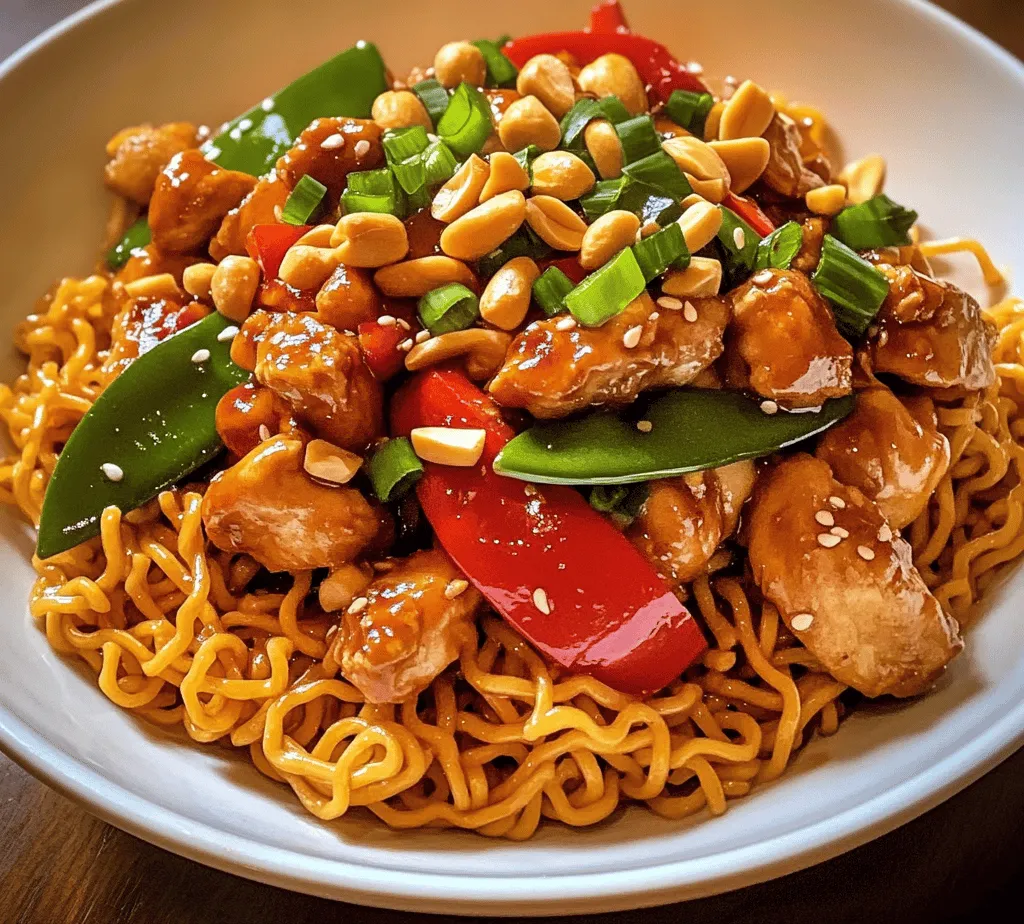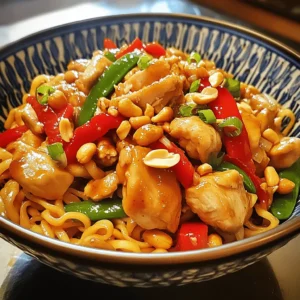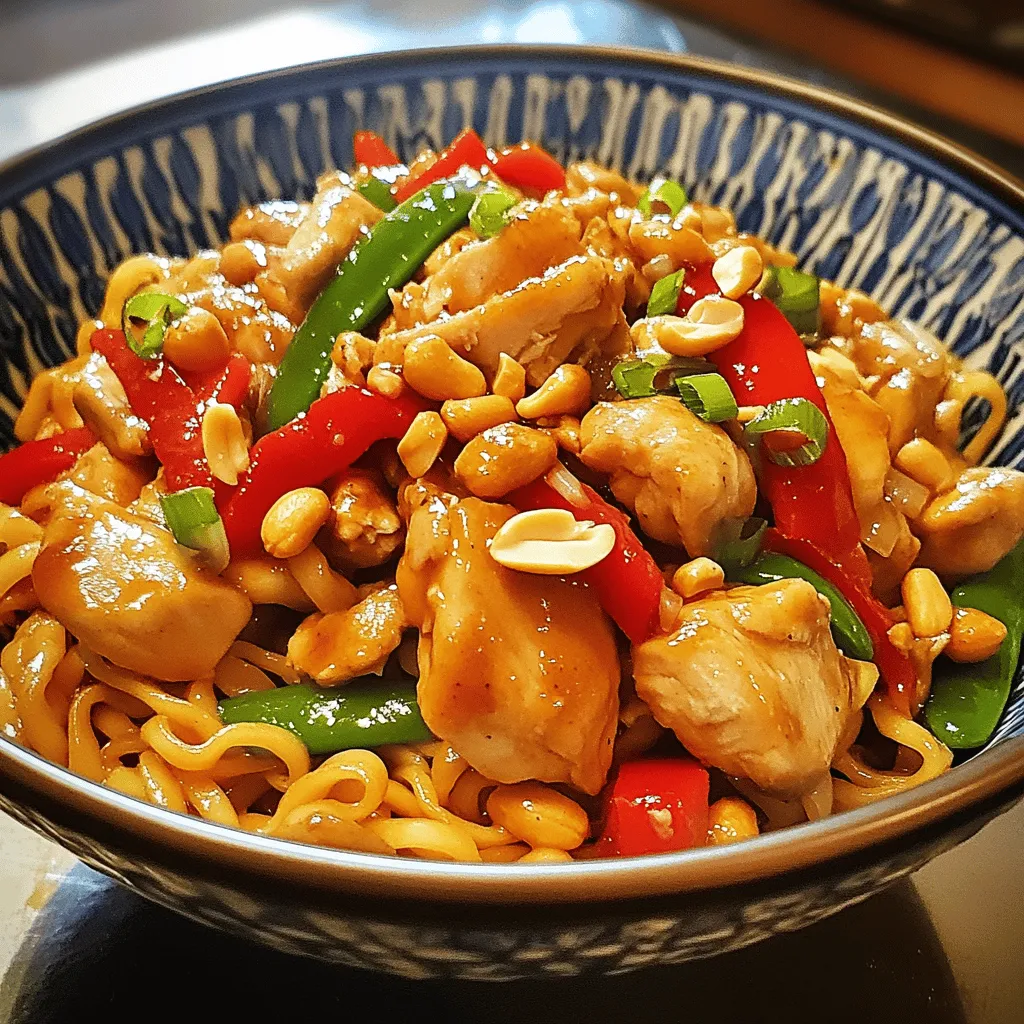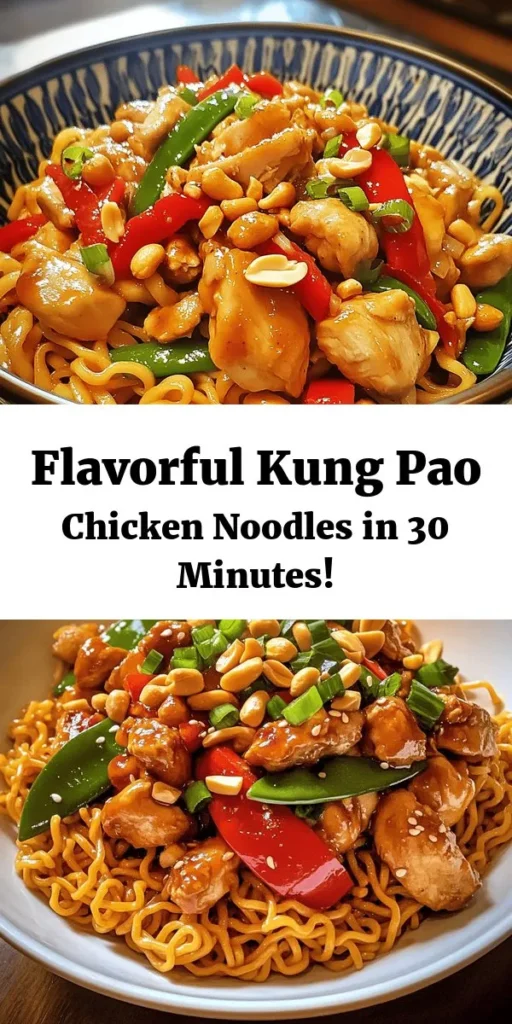Introduction
Welcome to the vibrant world of Kung Pao Chicken Noodles, a dish that perfectly marries the rich, spicy flavors of traditional Kung Pao chicken with the comforting texture of egg noodles. This culinary delight offers a tantalizing blend of protein, fresh vegetables, and the satisfying crunch of peanuts, making it a favorite among both novice cooks and seasoned chefs. The versatility of Kung Pao Chicken Noodles means it can be whipped up for a quick weeknight dinner or served as an impressive meal for guests, showcasing an array of flavors and textures that will leave everyone impressed.
Kung Pao Chicken, originating from the Sichuan province of China, is known for its bold flavors, characterized by a perfect balance of sweetness, heat, and nuttiness. By incorporating egg noodles into this classic recipe, we create a heartier dish that is not only filling but also brings a delightful twist to the traditional stir-fry. Whether you are looking to spice up your dinner routine or impress your friends at a dinner party, this dish is sure to satisfy.
In this article, we will explore the essential ingredients that make up this flavorful recipe, followed by a detailed guide on how to prepare it. So, roll up your sleeves and let’s embark on this culinary adventure!
Understanding the Ingredients
To create a truly memorable dish, it’s essential to understand the key components that contribute to the overall flavor and texture of Kung Pao Chicken Noodles. Each ingredient plays a vital role, enhancing the dish and making it the flavorful experience that it is.
The Chicken
When it comes to the protein in Kung Pao Chicken Noodles, boneless, skinless chicken thighs are the preferred choice. Unlike chicken breasts, which can sometimes dry out during cooking, chicken thighs are known for their tenderness and rich flavor. Their slightly higher fat content ensures that they remain juicy and succulent, even when stir-fried at high temperatures.
Using chicken thighs also allows for a more robust flavor profile, making each bite filled with deliciousness. Additionally, they are quick to cook, ensuring that you can have a flavorful meal on your table in no time.
The Noodles
Egg noodles are the star of this dish, providing a soft yet slightly chewy texture that perfectly complements the spicy, savory elements of Kung Pao chicken. These noodles are made with wheat flour and eggs, giving them a rich flavor and golden hue that elevates the dish aesthetically and taste-wise.
The beauty of egg noodles lies in their ability to absorb the flavors of the sauce, ensuring that every bite is packed with the signature Kung Pao taste. When cooked properly, egg noodles become delightfully slippery, allowing them to mingle seamlessly with the other ingredients in the dish.
Fresh Vegetables
No Kung Pao Chicken Noodles would be complete without a vibrant assortment of fresh vegetables. Bell peppers, snow peas, and green onions are common additions that not only add color but also a satisfying crunch.
– Bell Peppers: Available in various colors, bell peppers provide sweetness and a slight crunch. They are also rich in vitamins and antioxidants, making the dish more nutritious.
– Snow Peas: These tender, sweet peas add a refreshing crunch to the dish. They cook quickly, preserving their crispness and bright green color, which enhances the visual appeal of the dish.
– Green Onions: Also known as scallions, green onions contribute a mild onion flavor that brightens the dish. They are typically used as a garnish, adding a fresh note to every bite.
Peanuts and Green Onions
A key element of Kung Pao Chicken is the addition of unsalted roasted peanuts. These nuts provide a delightful crunch and a slightly earthy flavor that complements the other ingredients beautifully. The peanuts also add healthy fats and protein, making the dish more satisfying.
For garnish, chopped green onions not only enhance the aesthetic appeal but also add a burst of freshness that balances the heat of the dish. Their mild flavor contrasts with the more robust tastes of the chicken and sauce, ensuring a well-rounded flavor experience.
The Kung Pao Sauce
The Kung Pao sauce is the heart of this dish, creating the signature flavor profile that makes it so beloved. A harmonious blend of ingredients works together to bring sweet, savory, and spicy elements to life:
– Soy Sauce: This savory staple provides the base flavor for the sauce, adding depth and umami.
– Rice Vinegar: A splash of rice vinegar introduces a subtle tang that balances the richness of the soy sauce and enhances the overall flavor.
– Hoisin Sauce: Known for its sweet and slightly smoky flavor, hoisin sauce adds a unique depth to the dish.
– Crushed Red Pepper Flakes: For those who love a bit of heat, crushed red pepper flakes are essential. They infuse the dish with a spicy kick that elevates the Kung Pao experience.
The beauty of the Kung Pao sauce lies in its versatility; you can adjust the levels of sweetness, saltiness, and spiciness to suit your taste. This allows you to personalize the dish, ensuring that it caters to your preferences.
Step-by-Step Cooking Instructions
Now that we’ve explored the key components of Kung Pao Chicken Noodles, it’s time to dive into the cooking process. With our ingredients prepped and ready, let’s begin with the first step: preparing the noodles.
Preparing the Noodles
1. Boiling Water: Start by bringing a large pot of salted water to a boil. The salt will enhance the flavor of the noodles as they cook.
2. Cooking the Noodles: Once the water is boiling, add the egg noodles. Cook them according to the package instructions, usually around 4-6 minutes, until they are al dente. It’s important not to overcook the noodles, as they will continue to cook slightly after being drained.
3. Draining and Rinsing: After the noodles are cooked, drain them in a colander. To prevent them from sticking together, rinse the noodles under cold water for a few seconds. This will also stop the cooking process, ensuring they maintain the perfect texture.
4. Tossing with Oil: To keep the noodles from clumping, toss them with a small drizzle of sesame oil or vegetable oil. This will add a subtle flavor and prevent sticking as they wait for the other ingredients.
With the noodles prepared, you’re well on your way to creating a delicious plate of Kung Pao Chicken Noodles. In the next section, we will delve into the preparation of the chicken and the vegetables, bringing our vibrant dish to life!

Making the Sauce
Creating the perfect Kung Pao sauce is crucial for achieving the signature flavor profile of this dish. Begin by gathering your sauce ingredients: soy sauce, rice vinegar, hoisin sauce, sugar, cornstarch, and a touch of sesame oil. In a mixing bowl, combine 3 tablespoons of soy sauce, 2 tablespoons of rice vinegar, and 1 tablespoon of hoisin sauce. These ingredients will form the base, providing a balance of savory and tangy notes.
Next, add 1 tablespoon of sugar to the mixture. This sweetness will help balance the acidity of the vinegar and the saltiness of the soy sauce. Then, dissolve 1 tablespoon of cornstarch in 2 tablespoons of water to create a slurry. This step is essential for thickening the sauce as it cooks. Finally, drizzle in 1 teaspoon of sesame oil for a slightly nutty flavor that enhances the overall taste. Whisk these ingredients together until smooth, ensuring the cornstarch is fully incorporated. This sauce will coat the chicken and noodles beautifully, providing the signature Kung Pao flavor.
Cooking the Chicken
To achieve a perfect sear on the chicken, begin by cutting boneless, skinless chicken thighs into bite-sized pieces. Thighs are preferred for their juiciness and flavor, but chicken breasts can also work. Pat the chicken dry with paper towels to remove excess moisture, which can hinder browning. Season the chicken with salt and pepper, allowing it to absorb the seasoning while you prepare your skillet.
Heat a large skillet or wok over medium-high heat and add a splash of vegetable oil. Once the oil is hot and shimmering, carefully add the chicken pieces in a single layer, making sure not to overcrowd the pan. This ensures that each piece can sear properly, resulting in a nice golden-brown crust. Let the chicken cook undisturbed for about 4-5 minutes before stirring. Once browned, continue to cook for an additional 2-3 minutes or until the chicken is fully cooked through and no longer pink in the center. Use a meat thermometer to check for doneness; the internal temperature should reach 165°F (75°C).
Once cooked, transfer the chicken to a plate and cover it with foil to keep it warm while you prepare the vegetables.
Stir-Frying the Vegetables
With the chicken set aside, it’s time to stir-fry the vegetables. A mix of bell peppers, zucchini, and snap peas not only adds color but also provides a variety of textures. Slice the bell peppers into strips and chop the zucchini into half-moons for even cooking. Prepare about 1 cup each of sliced bell peppers (red and green), 1 cup of zucchini, and 1 cup of snap peas.
In the same skillet or wok, add another tablespoon of oil if needed and return the pan to medium-high heat. Add the vegetables to the hot pan, starting with the bell peppers and zucchini. Stir-fry for about 2-3 minutes until they begin to soften but still retain their bright colors and crunch. Add the snap peas last, as they require less cooking time. Stir everything together for an additional minute.
The key to successful stir-frying is to keep the vegetables moving in the pan, ensuring they cook evenly while maintaining their vibrant colors and crisp texture. Once the vegetables are tender-crisp, remove them from the pan and set aside.
Combining Ingredients
Now that the chicken and vegetables are cooked, it’s time to combine everything. Return the cooked chicken to the skillet and pour the prepared Kung Pao sauce over the top. Stir well to coat the chicken evenly in the sauce, allowing it to simmer for about 2-3 minutes. This step is essential for melding the flavors, as the sauce thickens slightly and clings to the chicken.
Next, add the sautéed vegetables back into the pan. Toss everything together gently, ensuring that the sauce envelops each ingredient. As you mix, take a moment to appreciate the transformation happening in the pan—the vibrant colors of the vegetables, the glistening chicken, and the rich, aromatic sauce. This is the essence of Kung Pao Chicken Noodles coming to life.
Incorporating Noodles and Peanuts
Once the chicken and vegetables are well combined, it’s time to add the noodles and peanuts. Begin by preparing your noodles according to package instructions. You can use Chinese egg noodles, rice noodles, or even whole wheat noodles for a healthier option. Once cooked, drain the noodles and add them directly to the skillet with the chicken and vegetables.
Incorporate the noodles into the mixture, using tongs or a spatula to toss everything together evenly. This ensures that the noodles are coated with the sauce and infused with the flavors of the chicken and vegetables. For an added crunch, sprinkle in about ½ cup of roasted peanuts at this stage. These peanuts will provide a delightful texture contrast and enhance the dish’s nutty flavor.
Toss everything together for another 2 minutes, allowing the noodles to heat through and absorb the sauce. Taste and adjust seasoning if necessary, adding a pinch more salt or a splash of soy sauce if desired.
Garnishing and Serving
Once your Kung Pao Chicken Noodles are fully combined and heated through, it’s time to plate them. Transfer the noodles to a serving dish or individual bowls. For an appealing presentation, consider garnishing with thinly sliced green onions and a sprinkle of sesame seeds. These toppings not only add visual appeal but also enhance the dish’s flavor.
For an extra layer of freshness, you can serve the dish with lime wedges on the side, allowing guests to squeeze fresh juice over their portions. This brightens the flavors and adds a citrusy zing to the dish.
Nutritional Breakdown
Kung Pao Chicken Noodles are not only delicious but also provide a balanced meal. Each serving offers a good amount of protein from the chicken, which is essential for muscle repair and growth. The addition of fresh vegetables contributes vitamins and minerals, such as vitamin C from the bell peppers and fiber from the snap peas, aiding in digestion and overall health.
The peanuts add healthy fats, which are important for heart health and can help keep you feeling full longer. Overall, this dish is a well-rounded meal option, providing essential nutrients while delivering bold flavors that satisfy.
Cultural Significance of Kung Pao Chicken
Kung Pao Chicken, known as “Gong Bao Ji Ding” in Mandarin, has deep roots in Chinese cuisine, dating back to the Qing Dynasty. The dish is named after Ding Baozhen, a governor of Sichuan province, who was fond of this spicy stir-fry. Traditionally, it features chicken, peanuts, and vegetables, all tossed in a flavorful sauce.
Over time, Kung Pao Chicken has evolved and adapted to various cultures, leading to numerous interpretations worldwide. In the United States, for instance, it’s often sweeter and less spicy than its authentic counterpart, reflecting local tastes. Regardless of the variation, the dish remains a beloved staple in both Chinese and Western cuisines, showcasing the versatility and adaptability of traditional recipes.
Exploring Flavor Variations
While the classic Kung Pao Chicken recipe is a hit, feel free to experiment with variations to suit your taste or dietary preferences. For a vegetarian option, consider substituting chicken with tofu or tempeh. Both provide a great texture and will absorb the flavors of the sauce beautifully.
You can also switch up the vegetables based on seasonal availability or personal preference. Broccoli, carrots, or bok choy can add a delightful crunch and additional nutrients. For a spicier kick, consider adding fresh red chili peppers or a dash of chili oil to the sauce. The beauty of Kung Pao Chicken Noodles lies in its adaptability—let your creativity shine!
Conclusion
Making Kung Pao Chicken Noodles at home is not only a rewarding culinary experience but also a delightful way to enjoy a classic dish that bursts with flavor. The ease of preparation, combined with the vibrant colors and satisfying textures, makes it a perfect meal for any occasion.
As you cook, embrace your culinary creativity, experimenting with flavors and ingredients to make this dish your own. Whether you’re serving it for a casual weeknight dinner or impressing guests at a gathering, Kung Pao Chicken Noodles are sure to delight the palate and leave everyone asking for seconds. So gather your ingredients, follow the steps, and enjoy the satisfaction of creating a homemade dish that has stood the test of time.



